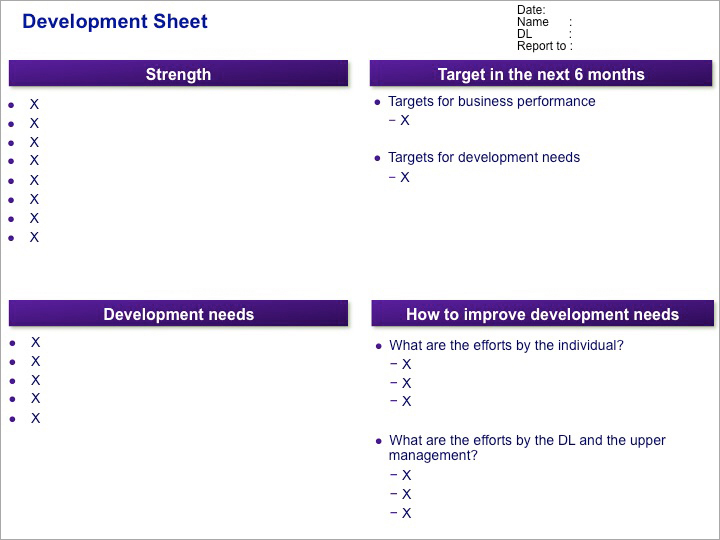I proposed that management innovation requires seven keys to unlock at the same time. I will now discuss in some detail the Fifth Key—Human Resource Development Committee whose mission is to understand the management team, to set performance and growth targets, and to foster professional development.
Know Your Best People
When you embark on management innovation, it is highly desirable to understand your management resources in the company. While it depends on the size of the company, if you have over a few dozen director and manager level people, it is difficult for CEOs to have a clear overview of the promising directors and managers in the company.
The CEO may be able to match directors’ and managers’ names with faces. How well does the CEO understand their strengths and their potential to contribute to management innovation? And of the next level leaders who report to them? —Probably not so well.
However, the middle managers are the driving force for management innovation, and how they can lead the teams on the ground and override resistance is key.
This is why it is critical for management innovation to identify the middle managers with strong leadership skills and high aspirations. They are not always outspoken, and while group general managers or business unit general managers may know who they are to some extent, often they are not visible.
Also, some group general mangers and business unit general managers’ understanding of the importance of management innovation and their determination to pursue it at all cost may be questionable. So you cannot believe everything they report at face value.
Therefore, it is desirable to establish a common ground by forming a Human Resource Development Committee that consists of the CEO and several top executives. The mission of the Committee is to identify the best people who can drive management innovation on the ground or in the Management Innovation Team, to set their performance and growth targets, and to agree on future expectations and ways to accelerate their growth.
Running the Human Resource Development Committee
The Human Resource Development Committee consisting of the CEO and several top executives discuss methods for growth and development of corporate officers and on down the line. The committee members interview their subordinates, write-up the Performance and Growth Targets Agreement, and present them at the Committee meetings.
Strengths, performance and growth targets for an individual are presented in four to five minutes. Then take few minutes to discuss how they might contribute to management innovation, and specific plan and assignments to help them grow.
As you hold more Committee meetings and the Performance and Growth Targets Agreement write-up becomes well practiced and prepared, 7 to 8 minutes will be sufficient to discuss an individual at the Committee. Discussions take longer typically when the presenter does not have a solid grasp the person being presented and cannot respond well to the astute questions by the Committee members.
After discussing everyone’s growth plans, recap big picture of number of managers capable of driving management innovation, how well they are utilized, and how far they can push management innovation. It’s effectively taking inventory of your forces you can count on before going to war.
After the Human Resource Development Committee meeting, Committee members provide feedback to the people they presented. The performance, growth targets and actions to achieve it are re-examined, clearly agreed, and the Performance and Growth Targets Agreement is revised accordingly.
The mission of the Human Resource Development Committee is different than the HR performance review meetings that may be in place. It is to identify leader prospects that can drive management innovation, to provide them appropriate assignments in line with their capabilities, and to discuss plans that can accelerate their growth.
In that sense, it is most appropriate for the CEO and the right hand top executives to lead the Committee rather than being facilitated by the HR department.
Performance and Growth Targets Agreement
The Performance and Growth Targets Agreement to be prepared for the Human Resource Development Committee meeting for an individual should be one page that consists of the following:
Left upper side, list 7 or 8 specific areas of strength. For example:
- Ability to drive improvements in spite of opposition
- Strong communication skills and ability to reason with and move those who resist
- Can execute jobs with attention to details while grasping the big picture
- Committed to growth and development of their subordinates and track record for doing so
Left lower side, list 5 or 6 specific growth challenges. For example:
- Effectively lead a few people, but unable to wield strong leadership for over 10 direct reports
- Becomes very discouraged in face of internal opposition, and execution gets bogged down
- Good at putting together reports, but, lack confidence to present and ineffective to convince
- Good at executing jobs, but shows little interest in the growth of their subordinates

Right upper side, describe the performance and growth targets. Performance target should consist of allocation from the company budget, and the tasks for management innovation. The growth target should describe verifiable specific improvements that correspond to the challenge areas described in the left lower side.
Right lower side, list specific approach to achieve the targets in two parts—what the individual is committed to do, and how the superior is committed to support and coach. One unique feature of the Performance and Growth Targets Agreement is that it clearly describes how the superior and the subordinate will endeavor in parallel to achieve the targets.
The superior is responsible for writing the Performance and Growth Targets Agreement. With practice, it should take less than thirty minutes to write one for an individual. However, it does require them to regularly pay attention to their subordinates with the intent to help them grow. It provides a great opportunity for the superiors to renew how they foster the growth and development of their subordinates. If you do not understand the subordinate sufficiently, perhaps because they are new hires, say so and complete the Agreement as you interview them.
Follow-up on the Human Resource Development Committee Meeting
Arrange a brief one-on-one interview with the subordinates to provide feedback from the Human Resource Development Committee meeting. Set up and conduct the interview as soon as possible as it is very valuable feedback and the subordinates are understandably anxious to hear the top executives’ assessment and the perspectives that were discussed.
Because it is a very rare occasion for middle managers to have the top executives including the CEO to have a meeting about them, they greatly appreciate such a feedback. It is an opportunity to raise their level of loyalty to the company.
Through the interviews, the individuals clearly recognize how their performance and growth targets contribute to the management innovation process and it will reinforce their commitment.
Merits of Human Resource Development Committee
Hosting Human Resource Development Committee meetings enable the top executives to form a common understanding in a short period of how their managers throughout the organization can contribute to management innovation.
In addition, through this process the CEO can reaffirm the executive management team’s commitment to management innovation, and increase the company wide momentum to make it happen.
Furthermore, there will be much for the CEO to discover, as the executives’ attitude towards management innovation and their commitment to the growth of their subordinates will become very clear through the Committee discussions.
The process will illuminate people that can take charge of management innovation, and distinguish those you can count on from those you cannot.
It is a very different approach from the HR evaluation process to determine pay raises and promotions. It is an indispensible key to management innovation.
For any suggestions or questions, please feel free to send me a mail to info@b-t-partners.com. I will get back to you right away.
Linkedin: http://www.linkedin.com/in/yujiakaba
▼ 7keys to accelerate Management Innovation
The Seven Keys to Accelerate Management Innovation
Need to Unlock Seven Keys to Start and Accelerate Management Innovation
The First Key:Change Vision and Strategy, and Let Everybody Know
The Second Key:Rapid Improvement of Existing Businesses
The Third Key:Developing Multiple New Businesses
The Fourth Key:Management Innovation Team
The Fifth Key:Human Resource Development Committee
The Sixth Key:Innovation in Boss-subordinate Relationship
The Seventh Key:Positive Feedback and Active Listening
ーーーーーーーーーーーーーーーーーーー
◆『ゼロ秒思考』赤羽雄二のオンラインサロンを始めました。
ご入会はこちら
https://community.camp-fire.jp/projects/view/318299
まずはLINEで診断を受けてみたい方はこちら
https://lin.ee/20Kdy9L
ーーーーーーーーーーーーーーーーーーー
◆Instagramを始めました。
フォローはこちら
https://www.instagram.com/yujiakaba
ーーーーーーーーーーーーーーーーーーー
◆音声プラットフォームVoicyを始めました。
フォローはこちら
https://voicy.jp/channel/2885
ーーーーーーーーーーーーーーーーーーー
◆まぐまぐ!メルマガ「赤羽雄二の『成長を加速する人生相談』」を始めました。
メルマガ購読はこちら
https://www.mag2.com/m/0001694638
ーーーーーーーーーーーーーーーーーーーー
◆赤羽雄二のLINE公式アカウントを始めました。
アカウントの追加はこちら
https://line.me/R/ti/p/@gtr8764i
ーーーーーーーーーーーーーーーーーーーー
◆メールアドレス(ご感想、ご質問など、お気軽にお寄せください)
info@b-t-partners.com







